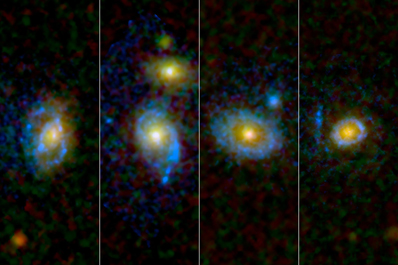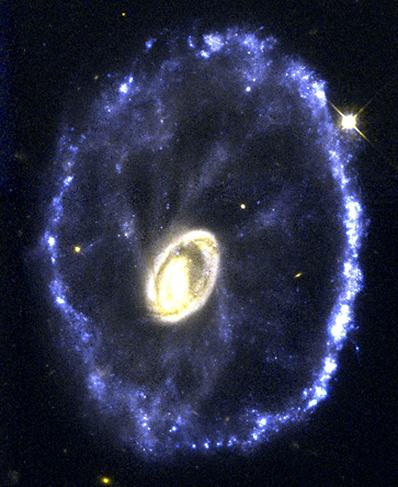


|

|
 |
|
Born-again galaxies with ultraviolet rings KEITH COOPER ASTRONOMY NOW Posted: 13 August 2010 NASA’s Galaxy Evolution Explorer (GALEX) has uncovered ‘old, red and dead’ galaxies that appear to have risen from the grave and grown rings of newborn stars, confounding expectations of what happens when a galaxy matures.  A selection of old red galaxies with blue and ultraviolet rings of star-formation. Image: NASA/ESA/JPL–Caltech/STScI/UCLA. A selection of old red galaxies with blue and ultraviolet rings of star-formation. Image: NASA/ESA/JPL–Caltech/STScI/UCLA.
When galaxies evolve, they lose the cool gas they use for forming new stars, and become dusty and red with the light of older, long-lived stars. This often happens when galaxies merge and form a giant elliptical galaxy, or when a spiral galaxy enters a dense galaxy cluster and is stripped of its star-forming gas to form a disc-shaped galaxy, lacking spiral arms, called a lenticular galaxy (see our related news story here). Blue and ultraviolet light is more typically associated with star-formation in less evolved spiral galaxies like the Milky Way, and the GALEX satellite has ultraviolet cameras to detect such activity in distant galaxies. However, Dr Samir Salim of Indiana University and Michael Rich of the University of California, Los Angeles, were surprised when they used GALEX to discover 29 of these ‘dead’ galaxies with an excess of ultraviolet light. Furthermore, when they used the Hubble Space Telescope to take a closer look, they saw that in 22 of the 29 the ultraviolet light was being emitted by structures around the galaxies, including 15 galaxies that had rings of ultraviolet light. The inference is that somehow these dead galaxies, which are on average 1.5 billion light years away, are forming new stars. How can that be the case, and why in the shape of rings? Salim and Rich set out to discover why. Ringed galaxies are not unheard of; the Hubble Space Telescope in particular has photographed galaxies with rings caused by a smaller galaxy plunging head first into the centre of a larger galaxy, causing ripples to expand outwards as though a stone had been dropped into a pond. But such head-on collisions are relatively rare, so Salim and Rich had to search for another explanation.  The Cartwheel Galaxy is a ring galaxy that formed when a smaller galaxy collided head-on with a spiral galaxy, but an alternative explanation had to be found for the rings found around old galaxies. Image: C Struck and P Appleton (Iowa State University)/K Borne (Hughes STX Corporation)/R Lucas (STScI)/NASA/ESA. The Cartwheel Galaxy is a ring galaxy that formed when a smaller galaxy collided head-on with a spiral galaxy, but an alternative explanation had to be found for the rings found around old galaxies. Image: C Struck and P Appleton (Iowa State University)/K Borne (Hughes STX Corporation)/R Lucas (STScI)/NASA/ESA.
The space between galaxies isn’t empty. It’s filled with gas, mostly hydrogen – the stuff from which stars are made. Salim and Rich suspect that these galaxies are gathering up large quantities of this gas. That explains where the gas to form the stars comes from, but why in rings? Many typical spiral galaxies have central bars that run through their centres, and these are often linked to ring-like structures encircling the galaxy. Despite having lost their spiral structure, lenticular galaxies can still have bars, which could explain the rings. Salim and Rich are planning on searching for more evidence for bars. Interestingly, while the ultraviolet excess is seen in galaxies with several times the mass of our Milky Way, even bigger galaxies do not seem to have these features. “Those may have a way of preventing new star formation from happening,” Salim told Astronomy Now. “Most massive galaxies are primarily ellipticals, so the ultraviolet excess that we see may be primarily a lenticular galaxy phenomenon, but we are still working on proving this.” Their work was published in the 21 April issue of The Astrophysical Journal. |
|
|
|
|